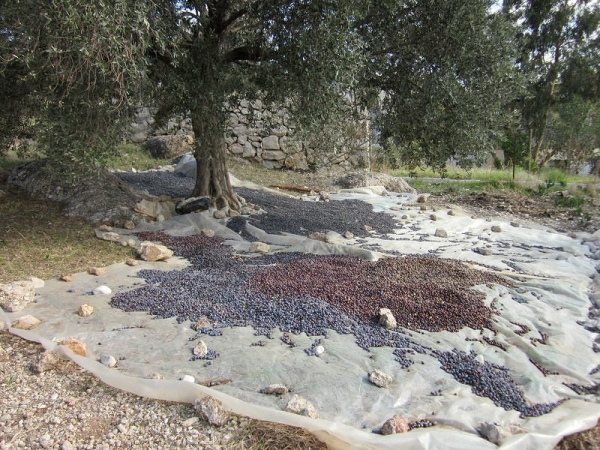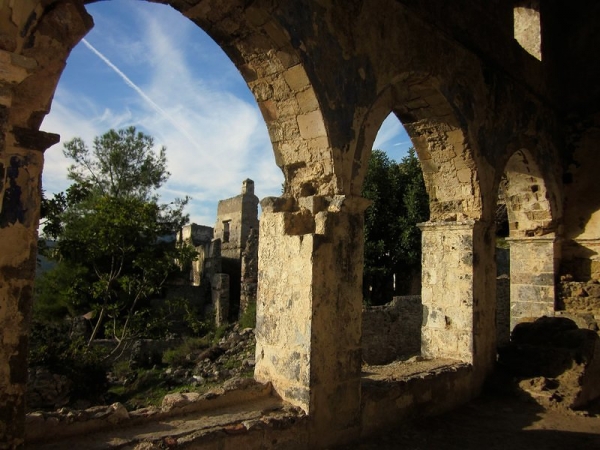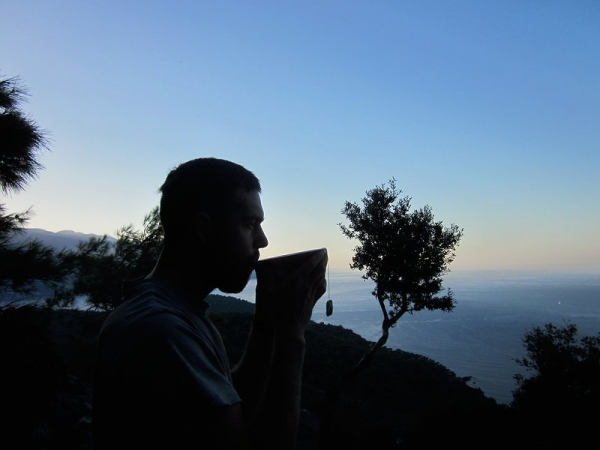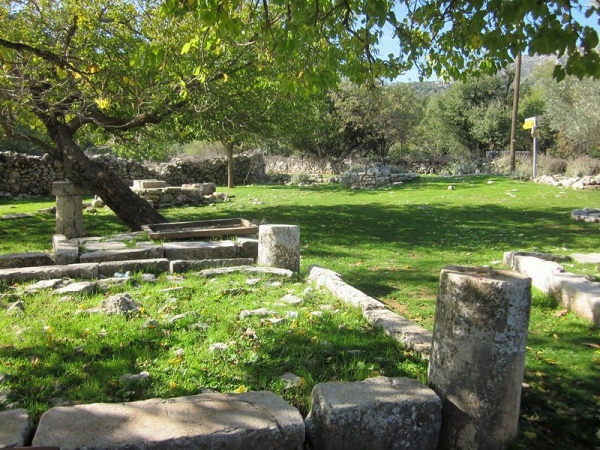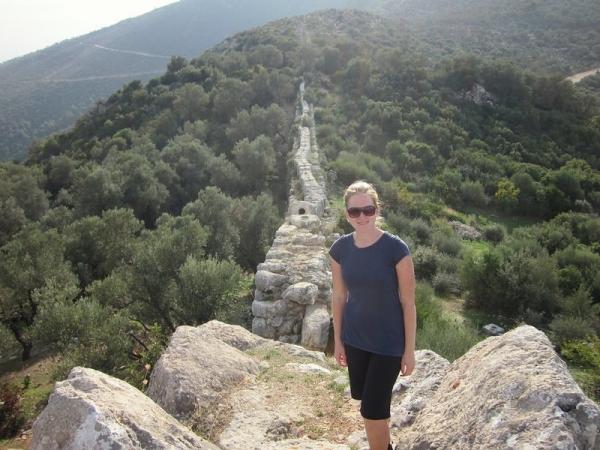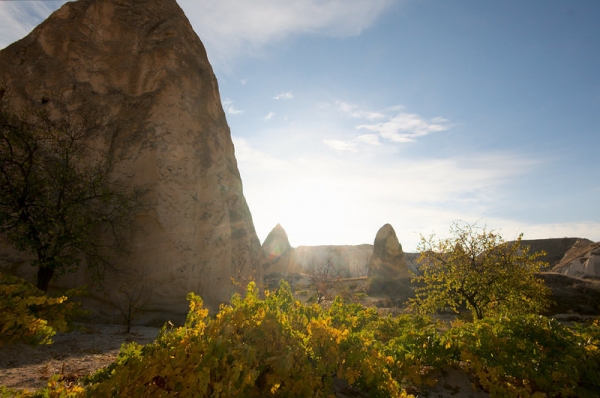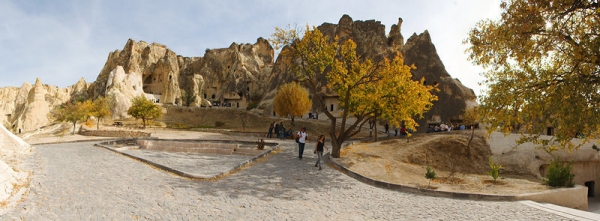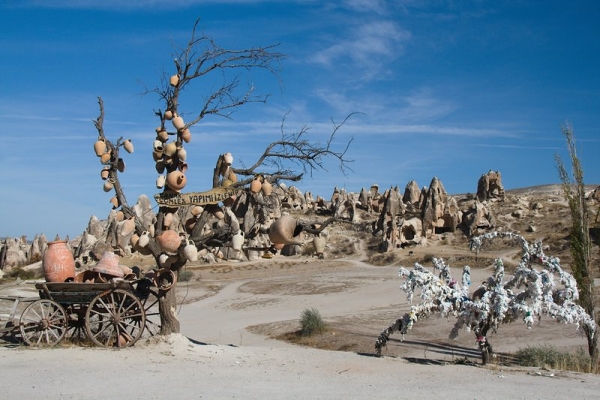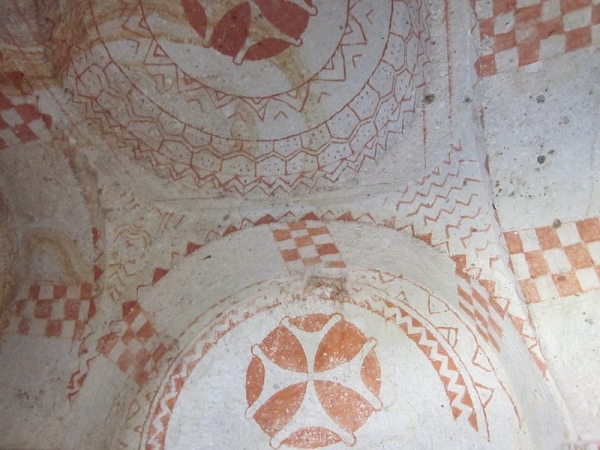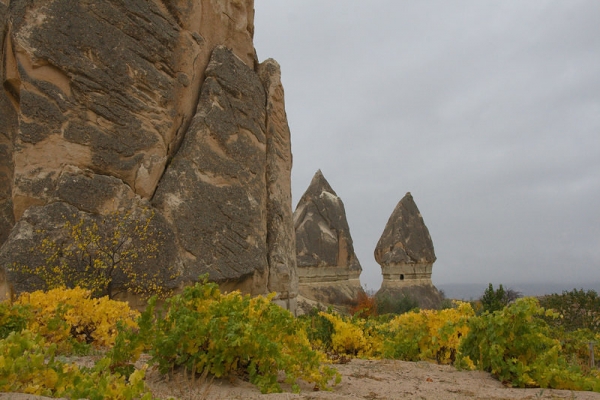This is Part 3 of 4. Click for Part 1, Part 2, or Part 4.
Day 8
Delikkemer – Delikkemer
20.5 km (8 hours, 45 minutes)
We started the day with a good hike. The new dog from yesterday was still following us, though even Mayhem seemed to keep her distance from him. We soon came across a flowing spring and filled up our water bottles. Typically, we tried to carry 3 L of water each. We filled took breaks to chug and fill up wherever we found a good source. As a note, we didn’t treat any of the water we drank and had no problems.
Good start to the day
Filling the water bottles at a spring
Hiking with “our” two dogs
The trail was easy to Patara, none of the scratchy brush we had dealt with the day before. We did, however, encounter a farm with several aggressive dogs. The three largest ones were particularly aggressive, but we needn’t worry – Mayhem and the other dog that was following us literally fought them off and kept them away from us. Mike threw a few stones too.
We passed a shepherd with his flock and, with a big smile, he handed us each an orange from his pocket. Mayhem thanked him by barking at his sheep, but we got her out of there before she could do some serious chasing.
We met up again with the Turkish hiker just before the ruins. He had decided he had enough of the trail and was ending his day and his trip in Kalkan.
There were no information signs at the ruins, but we still enjoyed spending a good hour or more roaming around them. There was no entrance fee and the locals seemed to use parts of them for grazing their sheep and goats.
Patara
Patara
Patara
Patara theatre
We had been planning to stop in the village of Gelemiş to stock up on food, but decided that we had enough in reserve to make it through the night and to the town of Kalkan the next day. This would save us about 6 km of walking.
On the walk back to Delikkemer (as I mentioned in the previous post, we were on an optional loop of the trail here), we passed a signpost for the trail that had a handwritten note taped to it. The note warned of three big, vicious dogs that had attacked the writer. These would be the same dogs we had encountered. We again felt grateful to have our fearless Mayhem with us. Our other defender gave up following us somewhere along the way. Again, Mike may have tossed some stones.
Olive harvest
Walking the Patara loop
Mayhem and me, taking a well-earned break
The road that was our trail
As we returned to Delikkemer, we realized we would be making camp there again for the night. We were very low on water – we had been conserving it all day as we hadn’t found a source since the morning. We stopped on the road before the trail branched back to the coast. I now had multiple blisters, especially on the backs of my heels and my baby toes. We decided that I should stay on the side of the road with our gear, while Mike hiked the loop back to the spring we filled up at earlier that morning.
I sat down and waited, digging a needle out of the first aid kit to start surgery on the embedded black thorns in my hand from my fall the day before. It started to rain – not a downpour, but not a drizzle either. About five cars full of locals stopped to make sure I was okay on their way home from picking olives in the fields. After about 20 minutes, Mike returned empty handed. He couldn’t find the spring. We had thought it was closer than it was. We knew it had to be there (we had just been there that morning, for goodness sake), so I sent him back out a second time.
After another 20-30 minutes, a car stopped and Mike got out. He had been picked up by a man, Hameed, that wanted to help out. Hameed drove Mike to a gas station on the highway, thinking he was planning to hike there anyways. When Mike re-explained that he had to come back to me and our gear, where we were planning to camp for the night, Hameed apologized. It was obviously out of his way, but he swore it was his problem, not ours and drove Mike back to me. He told us he owned a restaurant called the Aubergine in Kalkan (the next town we would encounter) and that we should stop in for a free coffee on our way through.
We hiked down the trail until we found a great spot to camp (even better than our spot the night before) and cooked a delicious meal of bulgur wheat flavoured with cream of vegetable soup.
Back at Delikkemer
View from our campsite
View from our campsite
Day 9
Delikkemer – Kalkan
4 km (2 hours, 30 minutes)
We woke up in the middle of the night to a massive thunderstorm. The lightning was blinding, even through the tent and closed eyelids. To make matters more interesting, one of the tent poles snapped. We waited out the storm and the sunrise, drifting in and out of sleep.
When it was finally time to get up, we crawled out of the tent to assess the damage. Luckily, the storm had ended and the rain had stopped by this point. Despite the broken pole, the tent kept everything more or less dry. As we took down the tent, we examined the broken pole. It had cracked lengthwise at the connection. This had obviously happened at one of the other connections, since it was already patched with fibreglass when we got it. The crack was about an inch-long and we didn’t dare use it again until we got it fixed for fear that it would damage the tent.
Puddle after the rainstorm
We had a few options for traversing the 4 km to Kalkan. We could risk injury on the sharp cliffs of the path we had inadvertently taken the day before yesterday. We could risk a different sort of injury on the sharp brush back to Akbel and then hike along the highway. We could risk the demoralization of hiking all the way along the highway that Hameed had driven Mike to the night before. We could hitch a ride on the now empty road. Or we could take the “magical ridgetop trail” that the locals use and Hameed had described to Mike the night before.
We decided on the the “magical ridgetop trail.” Who wouldn’t?
What I didn’t know when we set out is this: A. it was supposed to be a ridgetop trail (Mike left this part out before we left, and will be relevant not so later in the story), B. Mike had once again failed to consult a map to see where Kalkan was located, and C. Mike didn’t know “exactly” (his words, not mine) where the path began.
After several false reassurances that he knew what he was doing, we started the hike. We were smiling and joking, happy to have survived last night’s storm so unscathed (though we felt terrible for poor Mayhem, who was wet and shivering and looked miserable until we got moving). We started out on the waymarked trail, before deviating at one of the “X’s” that indicate you’re heading the wrong way. I asked Mike if he was sure he knew where he was going. “Yeah, pretty sure,” was his response, “I mean, I don’t know exactly, but I’ve got the gist of it.”
Before long, the “trail” faded and became a faint path through the scrub. Then it ceased all together. This is when I learned that it was described to Mike as a ridgetop trail. We were not on a ridge. Nor were we on a trail. I suggested turning back. Mike wanted to stubbornly plow on. “It’s gotta be here,” he said, as if in way of explanation. “I can see where I want to go, so I should be able to get there.” Now if that isn’t some solid logic to hang your hat on.
The problem was this: he couldn’t actually see where he was going. When we finally rounded a bend, there was no Kalkan where he expected Kalkan to be. This was no surprise to me. As I knew, and Mike was just learning, it was around yet another bend.
Meanwhile, the bush and brush got thicker and more treacherous. At this point, I’m going to quote from the daily journal we kept on the trail. We usually kept it in point form to get the main point down, but I was responsible for that day’s entry and I elaborated a little. This will give you a pretty good idea of how I felt:
– “trail” quickly became treacherous, sharp, pointy path of pain through and into sharp trees, sharp bushes, sharp sticks, sharp rocks, sharp leaves, and sharp thorns
– eventually, Mike climbed [up the slope] to actually figure out where we were going
– Ashley cried. Literally.
– Ashley fell. Literally. And cried again. She cried out and cried.
– Mike failed to offer a hand on any of the difficult bits – until Ashley pointed this out at which point she refused to take his hand
– let it be known that had we not been married already, after this “adventure” she likely would have refused his hand
Okay – so it was a bit of a dramatic exaggeration. We all know that even had we not been married, our relationship would have survived a little bushwhacking. And although I did cry, I didn’t cry and cry. But I was totally exhausted and exasperated from it all.
At this point, my blisters were “viciously sore” from the uneven ground we were navigating. We came across a trail waymarker by surprise and the mood instantly lightened. Until two minutes later when we realized we were following them the wrong way. Doh! This got us laughing. I decided that I could either stew about the last hellish hour all day, or I could forgive Mike and move on. I chose the latter.
We corrected our direction and the trail soon joined the road into Kalkan. We walked up the incredibly steep hill, with every dog in town chasing us and Mayhem down the road. Though we had only walked about 4 km in the last 2 1/2 hours, we both knew we were done for the day. We found ourselves a pansion in our price range and had a refreshing shower. Our pansion owner offered us a free coffee, and we sat on the balcony letting ourselves unwind.
Before we let the relaxation carry us away, we had some business to attend to. We gave our pansion owner our laundry (included in the price), and set out to get some repairs done. Mayhem happily greeted us on the street, where she had been waiting ever so patiently.
First and foremost, we needed the tent pole repaired. Second, Mike’s air mattress had been leaking since we got it. When we borrowed our gear, we never bothered to check that everything was in working order. His air mattress had a not-so-slow leak, and he was finding the flat mat on the ground a little cold and uncomfortable.
We went down to the harbour to see if anyone could do a fibreglass patch on the pole. We were unsuccessful, but we did come across the Aubergine restaurant where Hameed welcomed us with a smile and a complimentary cappuccino. We still were astounded by the hospitality of the Turks. At home, you buy a cup of coffee for the guy that did you the favour. Here, the guy that did you a favour buys you a cup of coffee. Go figure. The restaurant had a luxurious and peaceful atmosphere, and we blissfully enjoyed sipping our coffee and watching the sea while lounging on a comfortable patio couch. We were worlds away from our hiking “adventure” of the morning.
After coffee, we managed to get the tent pole repaired with packing tape at a clothing store (the owner had asked what we were looking for and, not knowing where us to send us, helped us to the best of his ability. He even gave us the roll of packing tape in case we needed more later). The air mattress was a no go. I offered to switch bed rolls with Mike for the next bit of the hike but, ever the gentleman, he declined.
We were getting hungry, so we hit up a supermarket and went a little splurge crazy. I guess that’s why you should never go shopping hungry (especially after eating nothing more than bread, cheese, yogurt, nuts, and chocolate for a week). We bought enough groceries to feed a family of six and went back to our pansion to prepare gnocchi in blue cheese sauce which we had with oodles of the veggies we missed while we were on the trail (a green salad, sliced beetroot, and olives). We rounded it all out with some Turkish style doughnuts.
Lunch
View from the balcony of our pansion
After this insanely large lunch, we lounged around in our hotel room, watching Battlestar Galactica on the iPhone. Finally, we dragged our lazy butts outside to try and walk off the huge lunch. Mayhem was, of course, waiting by the door.
Kalkan at night
We made it about two blocks before someone called down to us from a second story window. He asked how our holiday was going and we explained that we had just spent the last week hiking the Lycian Way and were taking today to relax. He introduced himself as Abdullah. He was the owner of the Ephesus restaurant in the same building (which was shut for the season like so many other places) and he invited us up for a çay.
We didn’t see any reason to turn down his invitation, so we climbed the stairs into the restaurant. The chairs were all stacked on the tables, but Abdullah quickly found us a cushioned couch to sit on and set about making some Turkish tea. We sat and chatted for a while with Abdullah and his friend, and then he asked us to stay for supper.
We were still full from our lunch, but didn’t want to be impolite. We told him we weren’t very hungry, but we’d stay for a little food. Our being vegetarian threw him for a bit of a loop, but he eventually served up a huge meal of lentil soup, pasta, salad, and of course – the Turkish staple – white bread. It started pouring rain, so we stayed and chatted into the night. When we left, Mayhem was no where in sight.
Day 10Rest Day in Kalkan
We woke up intending to continue our hike, but when we gathered up our laundry we discovered it was all still wet. We contemplated the prospect of hiking in damp socks and quickly decided against it (I suspect Mike would have pushed on anyways, but was happy to give me a rest day to help make up for the day before… maybe he read what I wrote in the journal). My heels were still raw which helped set my resolve – rest day it was!
Sore heels
Our timing really couldn’t have been more perfect. So far, we had avoided nearly all the rain of the rainy season during our daytime hiking hours. This day turned out to be a little grey, dreary, and drizzly. We happily snuggled into our warm, dry bed, watched some more Battlestar, read our books, and let our bodies recover.
When we finally ventured out, Mayhem was nowhere to be found. We figured she didn’t want to wait for us – she was a hiking dog, after all. To be honest, we were more than a little depressed by her departure and each time we went out, we found ourselves looking for her.
Later that afternoon, as we left the pansion to head to the grocery store, there was Mayhem! She wiggled and wriggled her whole body to say hello. On the way to the store she stuck close by our side, so happy to see us. We bought her some real food at the store (she had to be tired of white bread and that one dead sheep by now). We were happy to have her back!







